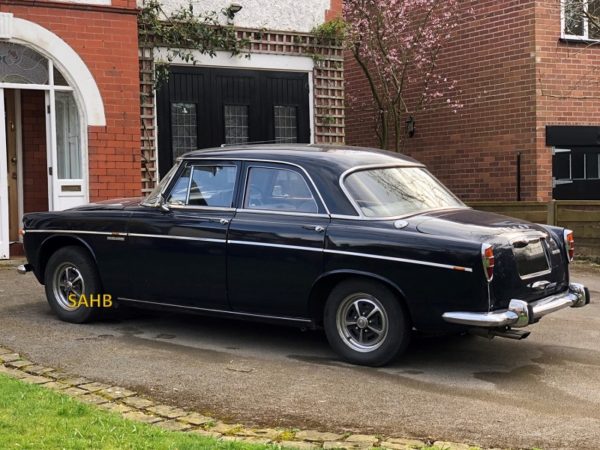
Some cars feel entirely at home in certain surroundings – and so it is with this Rover P5B on the drive of a modestly upmarket house in English suburbia. You can almost sense the folded copy of The Daily Telegraph left on the front seat (other newspapers are available according to taste).
The Rover P5 had a long and successful life in various forms between 1958 and 1973. Over 69,000 of these large saloons and coupés were sold. It was the first Rover car with a monocoque body, styled by David Bache, but its engine was not completely new: the 3-litre engine was a development of the 2,638cc powerplant in the range-topping versions of the P4 that preceded it. The P4 sold in parallel to the P5 until 1964 when the former was replaced by the far more modern P6, first sold as the Rover 2000.
The P5 was always marketed as a luxury car. Its dignified and elegant appearance and sumptuous leather interior appealed to business executives and professionals such as doctors who perhaps thought a Jaguar somewhat raffish. This did not deter Rover from introducing a more rakish coupé version in 1962 (at about the same time as the introduction of the more powerful Mark II), with a most unusual body: far from being the customary 2-door version of the saloon, it retained four doors but boasted a roofline lowered by 2½ inches, thinner B-pillars and a different instrument binnacle featuring a tachometer instead of the multi-gauge dial of the saloon. The minor gauges were moved to the sides of the binnacle.
The Mark III, again with more power, lasted from 1965 to 1967. It can instantly be recognised by the full-length chrome exterior trim that ended in three discreet chrome squares. It was replaced by the model in our Snapshot: the 3.5-litre P5B introduced in 1967.
In January 1964 Rover started to investigate the possibility of buying an American V8 to power their cars. The story of the discovery of the Buick aluminium engine has been told many times and in different versions, but the upshot was Rover’s purchase of the tooling from General Motors in 1965. The 1967 P5B was the first Rover to receive the new engine – and yes, the B stands for Buick. Borg Warner Type-35 automatic transmission, Hydrosteer variable ratio power steering and front Lucas fog lights were standard on the P5B.
Both the 3-litre and 3.5-litre versions of the P5 were used by senior British politicians, including Harold Wilson, Ted Heath and Margaret Thatcher. These cars were kept in operation by the UK government long after the end of production in 1973 until finally replaced by Jaguars in the 1980s. And Her Majesty the Queen used several P5 cars for her private motoring.







Leave a Comment